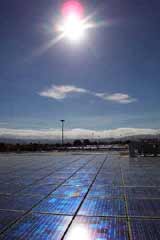
The Alameda County Santa Rita Jail in Dublin, California (see photo) will host the largest roof-top solar electric system in the U.S. (the fourth largest in the world). PowerLight Corporation will expand the Jails existing solar array from 640 kilowatts to 1.14 megawatts – to provide 30 percent of the facility’s power needs. Along with energy efficiency improvements, the system will save the county $400,000 the first year, and $15 million over its 25-year lifespan.
[sorry this link is no longer available]
— — —
For the past seven years, Vestas Wind Systems (Denmark), the world’s largest wind turbine manufacturer, has owned a 40 percent stake in the second largest manufacturer, Gamesa Eolica (Spain). The companies have parted ways and Gamesa bought its shares back. Gamesa is also purchasing the Navarre government’s nine percent stake to buy back 100 percent of the company. Analysts say Gamesa’s plans to expand in the Danish company’s markets caused the rift.
Will Vestas buy Enron Wind, the only U.S.-based manufacturer of utility-scale wind turbines? Vestas plans to begin manufacturing wind turbines in the U.S. if the U.S. Production Tax Credit (PTC) is extended. The company’s goal is to increase its world market share from 18 percent to 25-30 percent in coming years. Gamesa Eolica had a 14 percent market share last year. Now Vestas has a new competitor.
[sorry this link is no longer available]
[sorry this link is no longer available]
[sorry this link is no longer available]
— — —
In a mere four months after breaking ground, 50 new wind turbines are operating in Wyoming. The 1 MW turbines are owned by a subsidiary of Shell WindEnergy, Rock River I, LLC. This project is the first major investment by Shell in the U.S. wind market. SeaWest WindPower built the wind farm which will power 13,000 homes. David Jones, Director of Shell WindEnergy says, “Wyoming, and indeed the U.S., has huge potential for wind energy and we intend to become a major player in the wind energy market here.”
— — —
The UK government announced that 20 percent of its energy will come from renewable energy by 2020, upping the ante from its previous commitment to achieving 10% by 2010). Patricia Hewitt, the industry secretary, also announced that by 2010 up to 10 percent of all new cars will be powered by hydrogen and fuel cells. Renewable energy generates 2.6% of the UK’s electricity now.
— — —
Although it would have funded all of Switzerland’s social security costs, a new energy tax was voted down by 77 percent of voters last week. All forms of non-renewable energy including hydroelectric would have been taxed. Opponents objected to taxing hydro and to the lack of a ceiling on the eventual size of the tax. The government indicated its continued support for green tax reform and will consider a tax on carbon dioxide beginning in 2004.
— — —
Fuel Cell Technologies (FCT) of Canada and NKK Japan have made a deal to sell FCT’s solid oxide fuel cell products (SOFC) up to 50kW in size in Japan and East Asia. NKK Corporation is a prominent Japanese company and is an important partner for FCT, a developer and manufacturer of small-scale, stationary SOFC power systems. These systems power buildings such as homes, small commercial enterprises, and remote sites.
Last month, Ballard Generation Systems (BGS) (stationary power subsidiary of Ballard) and EBARA Corporation announced they would work with Osaka Gas to develop stationary proton exchange membrane (PEM) fuel cell cogeneration power generators for the residential market in Japan. Working with Osaka Gas opens the door for fuel cell energy production for its 6 million customers.
— — —
25 percent of the power of a 300,000 square foot Ford Motor Company building will be generated from fuel cells. The Irvine, California building is the North American headquarters for Aston Martin, Jaguar, Land Rover, Volvo, and the international headquarters for Lincoln Mercury. The building is the first in Orange County and only the third in California to receive LEED certification from the U.S. Green Building Council as a green building. UTC Fuel Cells, a subsidiary of United Technologies Corp., supplied the fuel cell power unit.
A hog farm in the Guangdong province of China, 90 miles northwest of Hong Kong, is the site for China’s first fuel cell, also supplied by UTC Fuel Cells. Hog waste will power the fuel cell. “This installation is not only a milestone for UTC Fuel Cells, but for the fuel cell industry as a whole,” says UTC Fuel Cells President William Miller. “China is a tremendous potential market for distributed electrical generation and for clean fuel cells.”
— — —
Manhattan Scientifics’ fuel cell bicycle has been named one of Time Magazine’s “Inventions of the
Year 2001.” Compressed hydrogen is stored in a 2-liter canister in the frame; it has a range of about 50 miles, twice as far as electric bikes, and a top speed of 20 miles per hour. The bicycle will be on the market in 2003 costing about $2,300.
Further Reading:
The Coming Hydrogen Economy , Fortune Magazine
Fuel cells powered by hydrogen are about to hit the market. In time, they’ll let us kiss the sheikhs goodbye.
Energy News

Published on: December 15, 2001
(Visited 41 times, 8 visits today)